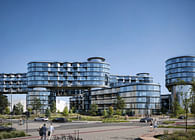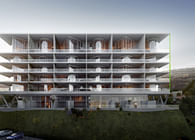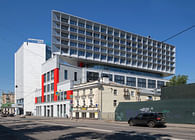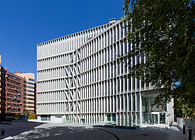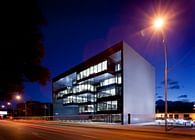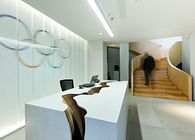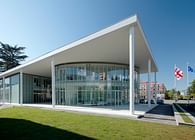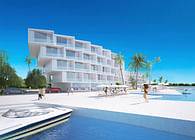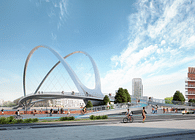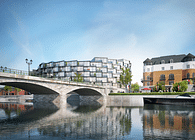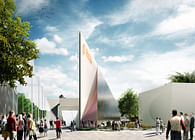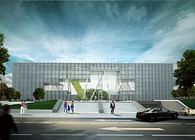
London, GB | Tbilisi, GE
National museum of korean literature
The Site The site is currently vacant. From three sides it has no surrounding roads. The access is restricted to 15.5m width from the North-West side, where the pavement changes its texture. The slope drops by 9m from South-East. The longest border is adjacent to the scheduled by 2022 development of the Arts Village residential area. The site area 13, 248 m2 with very narrow shape at the South-West corner.
Topography and Natural Environment
Located at the west side of Bukhansan National Park and the boundary of Eunpyeong New Town, the site has an affluent natural environment where Bukhansan Mountain is on the east and Imalsan Mountain is on the northwest. The Neighborhood Park of Gijachon District 1 adjacent to the site was formed in 2014, with a gate ball court, fitness center, forest playground, outdoor stage, and others outdoor experience. Among the eight Bukhansan Dulle-gil courses that are stretched south and east of the site, Cloud Garden and the Eunpyeong trails are connected. The height difference between the 124m altitude of the pedestrian passage of the Arts Village and 133m altitude of the trail adjacent to Bukhansan Dulle-gil is about 9m.
Design overview The envisioned building for this museum is arranged on 3 levels, including basement. Its overall height above ground (building shape) is 25m. The building footprint is a prolonged trapezoidal form of 112,500m long by 75m at its shortest side. The total footprint area is 7,253.5 m2, which is about 55% of the site area. The building is situated in the middle of the plot creating front and back outdoor areas. The building volume is positioned at the lowest level of the site’s sloped landscape and its roof profile aligns with the landscape behind the building providing easy access to the roof garden. The entire roof-surface serves as an outdoor garden for leisure purposes with views towards the built-up area and mountain range.
The main entrance to the site, for both vehicles and pedestrians, is accessed at the North-West side, at the end of Yeonseo-ro within 15.5m access area. Pedestrian access is to the left towards the main entrance of the museum; vehicles enter on the right, towards the drop-off, the carpark entrance and the delivery point at the far end of the building. The main entrance to the building is organised at the front yard from the North, which is flattened as a result of a cut-out landscape.
There are three levels to the building: The -1 floor has a double height main storage facility, M&E rooms and a car park; The ground floor includes the main entrance to the building, an administration office, a double-height main storage facility, M&E rooms and a car park. The +1 floor includes a museum and its supporting facilities, a museum shop, a cafeteria, a community hall, and education facilities.
Four stair & lift cores serve as the building circulation and maintenance. There is a goods-lift with direct access to the museum facility. The main entrance is a triple height space with reception, toilets, two stairs and lift core at the both ends. Large circular stairs give access to the first-floor museum area.
The Architecture of the building is a collection of randomised shapes formed by vertical walls which meander through the building creating the building mass. The two lower floors are organised as back-of-house with regular flat slabs and columns, where the first floor is an arched space cut through the walls creating a large open space to encapsulate the main museum and community facilities. Transparent and translucent glass partitions segregate functional spaces where necessary. NMKL thus realises a space that symbolizes multi-dimensional enjoyment of Korean Literature.
In order to achieve this kind of architecture, 3D Concrete Printing Technology is feasible to be utilised. In comparison with traditional concrete formwork building, 3D printed technology makes very complex shapes and structures possible with a significant reduction of cost, time and materials. This gives a unique quality as the singular materiality of concrete is maintained throughout the exterior and interior of the building. Ecologically sustainable mixing aggregates, such as clay, basalt, fibreglass, offer different colours and textures creating a most exciting architecture.
MANIFESTO
The story is printed by us Just as ink revolutionised the written word, the printing press revolutionised book publication– 3D printing revolutionises architecture, how we build, with a view to innovation and sustainability. Cheaper, quicker, easier— sustainable. The importance of literary culture is promoted by bringing future technology and innovation – narrative and form combine, printed in an architectural gesture.
Hand drawing manifestation In re-establishing the primacy of hand-drawing and its original possibilities in the making of buildings, the 3D printing approach is more sensual than it first seems. A return to the rudimentary skills of a drawing using the printing tool makes art of buildings. The manifestation of a hand-drawing, printed to form a building opens amazing possibilities in the expression of cultural and expansive gestures within the built environment.
The rational vs the irrational in architecture The comparison of a free-hand movement with controlled structural patterns highlights the contrast between 3D printed and traditional construction technology. Traditional concrete technology follows established methods, bound to the supply chain production rationalisation of manufacturing, which insisted upon technology based on the formwork dimension governed grid.
3D technology eliminates this notion of the grid-based rationalisation systems by using ‘singular’ material and its bottom-to-top layering method. No more factory-based rationalised supply chain systems. Post-rationalisation collides with a rationalisation of the meaningless combination of elements confined to a sequence forming a conglomerate of an organism, while the organism is a singular motion, technique, material and a free form. No more container stacked rectangles. Shape does not matter, if the rational resonates with the desired outcome. The expression of thoughts, unconstrained by technology leads to a liberation of thought itself. Just as ink made it possible to record and translate thought, not only in the form of words as symbols, but also in the generation of stories. A story can be anything, a narrative, a multi-layered, polyphonic, flowing whole—why should architecture be constrained by building blocks, unable to fully express itself, always relying on a heavy industrial supply chain?
Singularity The singularity I’m referring to points to essential and ultimate ways of living. It is the creating of singular solutions for multiple functions, forms and purposes. It is difficult to reconcile architecture’s singularity with the awareness of its multiple conditions and consequences. There is a fragile boarder between the Post-humanistic scientific approach and more traditional humanism with the emphasis on the singular. Parametricism denies human input except for a methodologic matrix control. All parameters are pre-set in the given conditions of the place (sun, wind, climate, market conditions, programme) so human input is a monitoring stance, making choices in a random order, mostly based on the intuition.
Singularity focuses on architecture as a singular object - aesthetic, formal, self-contained and irreducible to the conditions from which it emerges or the effects it stimulates. Architecture is an isolation from determining multiplicities or programme, creating homogeneous unity in a homogenous space. Functions can no longer be differentiated but they are alienated into ephemeral hybridisation.
The Challenge in the Principle is this: the post-humanistic (that is, robots) versus the human (that is, the individual/singular). Architecture can no longer be critical, because it depends on pre-determined, automatic choices of the parametric input matrix, which we, as a society, made possible by accepting the notion of progress via google, uber, amazon and grasshopper.
Status: Competition Entry
Location: Seoul, KR
Firm Role: Principal Designer
Additional Credits: Nikoloz Japaridze, Ilia Gamisonia, Simon Gatehouse, Eka Kankava, Stefan Nest
